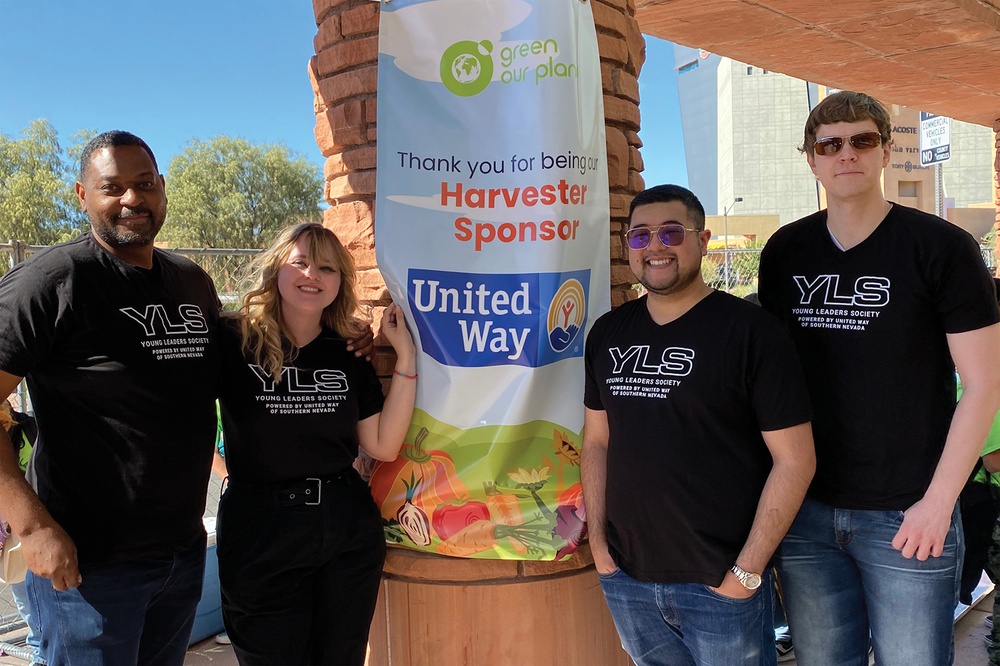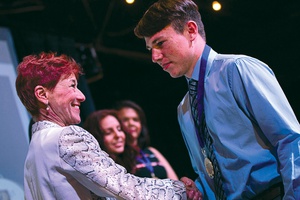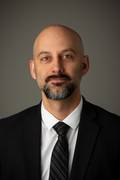There may be no destination as welcoming as Las Vegas, but as a place to live and work and grow—a true home—it’s a bit elusive. Las Vegas takes a while.
New residents might hear this from longtime locals: It takes a couple years to get used to it, and we’re not talking about the summertime heat. There’s something about this place that requires patience for meaningful connection … but once you’ve found it, it tends to click into place. You discover your community or culture or cause, and now you’re invested. Being local means making a contribution.
It sounds pretty normal, actually. Maybe Las Vegas is not all that unique in this way, but the important difference is this: This place desperately needs you to find that meaningful connection. It’s the only way it will become the Las Vegas we all want it to be.
“I’ve been here more than 35 years and one observation I’ve made is the fact that we are a community of people from elsewhere, right? The fundamental psychology of our community still seems to be that we occupy the community as a rental car rather than our own car,” says Punam Mathur. “You ask someone where they’re from, and the answer is, ‘Cleveland, but I’ve been here 25 years.’ At what point do you change allegiance from Cleveland to here?”
Currently the executive director of the Elaine P. Wynn & Family Foundation and a board member at the Moonridge Foundation, Mathur has long been a leader in Las Vegas, including executive positions at MGM Resorts International and NV Energy. The Wynn foundation’s mission is focused around serving at-risk youth in Clark County and offsetting the effects of poverty in public schools by providing resources from basic needs to intense case management.
The Moonridge Foundation, established by Julie Murray’s Moonridge Group consulting firm, programs the annual Philanthropy Leaders Summit forums in Las Vegas and Reno (among other initiatives), bringing together funders, corporate leaders and community advocates. “What the summit does is it recharges folks, clarifies in our own minds what the next level is going to be,” Mathur says. “It brings together in one space people who don’t come together very often … and there’s a rejuvenation that happens.”
It brings together locals who are making a contribution and provides opportunity for collaboration among those who have decided to change their allegiance to Las Vegas, no matter where they came from or how long ago they arrived. Gatherings like these are crucial for community growth because as a young city, the Las Vegas metropolitan area doesn’t have a large number of the traditional bedrock organizations that fuel philanthropy and social services in older or larger cities.
“It’s part of the maturing process. If you go to Boston, there are just dozens of big foundations helping make a difference,” says Bob Brown, president and CEO of Opportunity Village, one of Southern Nevada’s most prominent nonprofit organizations that just happens to be celebrating 70 years in 2024. “You just don’t have that here at this point and it is … partly because you have a lot of people here who came from other places, and sometimes they retire and go back. And it’s interesting that a lot of that money follows them.
“Now you’ve got more folks who have been born and raised here, this is their community, and you’re going to see a lot more of that in future years, people making money and keeping it here. And you see it starting with more younger people being more entrepreneurial in the community and connecting with and helping nonprofits.”
Opportunity Village has been serving local people with disabilities since 1954 through workforce development and employment, inclusive housing, arts and social recreation and other programs, and is recognized for funding its programming through social enterprises and events like HallOVeen, the Great Santa Run and the Magical Forest. It’s continuing to grow this year with its first new location in three years, the East Las Vegas Neighborhood Club on Bonanza Road, which opened in February. Next up will be a fall groundbreaking for the $55 million Northwest Community Center and Betty’s Village North project, near the Beltway and Decatur Boulevard.
Many Las Vegans can identify Elaine Wynn as a philanthropist or have heard about Opportunity Village’s mission or participated in one of its events. Most Las Vegans would probably say their community is a generous one, especially when times get tough during a global pandemic or after a tragedy like the October 1 shooting.
But anecdotal information can’t paint a clear picture of what kind of philanthropic culture exists in Southern Nevada, and how it can be supported and sustained moving forward. Nevada Grant Lab, a nonprofit founded in 2020 to help other nonprofits as well as local governments and state agencies maximize federal funding, offers vital info through its 2023 Nonprofit Sector Analysis report.
While there are thousands of registered 501(c)(3) nonprofit organizations in Nevada, approximately 660 of them have recorded any significant measure of economic activity.
“That speaks to how there are a lot of people motivated to do something good, but there’s a big gap between the ambition and the ability to do it,” says Miles Dickson, CEO and president at Nevada Grant Lab.
And that’s why his organization was created; despite its high needs, Nevada has historically secured some of the lowest amounts of federal grant funding in the country. Grant Lab aims to collaborate with organizations, corporations and citizens to streamline the complicated process of applying for federal grants, and to build the overall giving capacity in the community through education.
“Government funding is the bedrock of how we pay for things, from the arts to affordable housing to workforce development. If we’re missing the bedrock, we don’t have anything to build on,” Dickson says. “More philanthropy is great, but if we’re trying to really move the needle, we need funding from all of the above sources.”
The report compares Las Vegas to similar cities across the country— San Antonio, New Orleans and Orlando—and finds that Las Vegas has the smallest nonprofit sector. New Orleans has approximately 51 active nonprofits per 100,000 residents, more than three times the representation in Las Vegas (15 per 100,000). And while nonprofits here may have similar assets and revenues as their national counterparts, since there are far fewer organizations in Las Vegas, the impact across the region is substantially challenged.
Certainly there are nonprofits that are thriving, but for this dimension of the community to grow along with the rest of Las Vegas, we need more of that success, and that means building stronger, sustainable organizations. Nevada’s nonprofit sector is undersized, underfunded and understaffed, according to the Grant Lab report, and Dickson says the amount of funding the state is missing out on is fundamentally undermining this community’s ability to grow and serve its residents.
“What people in Southern Nevada don’t realize is all that traditional money that might be available in Alabama or Illinois or some other place is generally available to anyone,” says Beverly Rogers, chairman of the Rogers Foundation. “There are many corporate foundations where the money is good all over the country—Ford, Gates, thousands more, and there are directories to point to the people there.
“Southern Nevada receives the least amount of federal grant money of anybody in the country and has for the last 50 years, because no one applies for it. We walk away from money every year.”
The Rogers Foundation, one of the largest privately funded charities in the state, focuses on creating educational and artistic opportunities for Clark County students and teachers. It offers college scholarships for Clark County public high school students and supports Educate Nevada Now, the CORE program at several schools, and the Black Mountain Institute at UNLV.
And last year, Rogers opened the Beverly Theater, a new home for film, literature and music in Downtown Las Vegas. So far, it’s proved to be a cultural dynamo.
“This is without a doubt the most gratifying thing I have ever seen that I’ve been a part of,” she says of the theater. “It’s the grand piece of the arts portion of our mission, other than what we do specifically for students who are art students.”
Rogers and Dickson agree that there are some serious state government and policy issues that are stifling philanthropic and charitable efforts (and that’s the focus of Educate Nevada Now, a policy organization working for fair and equitable education in Nevada). Dickson says the nonprofit sector is overtaxed and small, and so organizations haven’t been able to invest in essential areas like donor and federal funding acquisitions.
“Many of us have been working in the Legislature for years to move forward, and we’ve made progress but haven’t seen the results of that progress yet,” he says.
Reshaping state policies that govern giving and nonprofits is a “very long fight,” Rogers says, but another challenge that could yield quicker results is the effort to build connectivity and collaboration. Technology and social media have made it easier for neighbors to become funders, for people to easily find worthwhile causes and organizations to which they’d like to donate time or money. Foundations and nonprofits are starting to make better use of new tools as well, and those connections should extend beyond the sector, Dickson says.
“There is a lot of opportunity for more partnerships and collaboration between local and state policy makers and philanthropy. They feel very disconnected right now,” he says. “It’s about recognizing if we want to something on a certain topic, there’s not just one nonprofit that’s going to do that, it actually takes all these people together … across multiple jurisdictions. We’re really leaning into the intersectionality of these issues and recognizing if you really want to make progress in this region, it takes all of us together sitting around the table, figuring it out and executing it.”
Back at Opportunity Village, Brown notes that executives from some of the larger local nonprofit groups meet up in the CEO Exchange, banding together to talk about job fairs, overall advocacy and social issues that cross over into different groups’ areas of focus.
“There’s not a competitive nature to it—you get that in the private sector. It’s about how many people can we help,” Brown says. “We have a lot of different facilities and other organizations use them and are really involved.”
Sustainability requires planning for the future, and although great demands are placed on local organizations to generate real-world results today, there’s an obvious emphasis on building for tomorrow. Another of the Las Vegas Valley’s most prominent groups, United Way of Southern Nevada, recently relaunched the Young Leaders Society, a burgeoning network of young professionals dedicated to serving the community.
“It’s an amazing group of people all under 40 who have committed to a giving threshold to support United Way in addition to doing some direct engagement with volunteer opportunities,” says Julian High, president and CEO of UWSN. “This has been part of United Way for a number of years and we sort of reactivated it after COVID.”
Shelby Sutter is a board member for the Young Leaders Society and says the giving group members share a passion for advancing community solutions in Southern Nevada. “I think the pandemic kind of left a hole for young people to come into the giving space and actually see what happens from the ground up,” she says. “I got to participate in grant reviews as a [new] donor, and now being on the board, we are building up that education and awareness and just getting everybody back out there saying we’re here, we haven’t stopped, we’re back post pandemic and we’re bringing our friends.”
Sutter notes YLS is big on embracing those modern trends like crowdfunding and social media activism, recognizing these new ways to bring someone into the world of charitable service.
“One thing I love about this group is the energy and desire to be connected to the work, and that’s really important,” says High. “If people can see and touch where their dollars go, they’re more likely to lean into making things better. It’s something I’m always in awe of, the energy and commitment from this YLS group to be in touch with the work, and that portends well for United Way and for the Valley.”
It sounds a lot like an example of the next generation of Las Vegans demonstrating their allegiance to the community, identifying their true home, and realizing what it takes to make things better and help those around them. Whatever bedrock exists, there are layers being built.
“We’re on our way,” Sutter says. “We don’t have the same stories or the extremely long history some of those other cities have, but I don’t think it matters when you have people who are top-notch. We care. We’re motivated, driven, passionate and resilient, and we’re here. It’s happening.”
Click HERE to subscribe for free to the Weekly Fix, the digital edition of Las Vegas Weekly! Stay up to date with the latest on Las Vegas concerts, shows, restaurants, bars and more, sent directly to your inbox!







